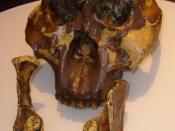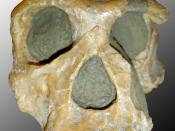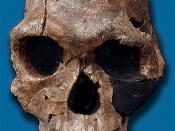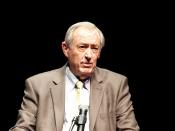Introduction to Anthropology Linda Samland June 21,2002 Biography- Richard Leakey Homo habilis, Richard Erskine Leakey, was born December 19, 1944 in Nairobi, Kenya. His parents were the esteemed anthropologists Louis and Mary Leakey. Leakey decided at an early age that he wanted nothing to do with paleoanthropology and dropped out of high school. Over the next few years Leakey trapped wild animals, supplied skeletons to institutions, started a safari business and taught himself to fly. In 1964, he led an expedition to a fossil site he had seen from the air and discovered that he enjoyed looking for fossils. He also discovered that although he technically led the expedition all the fame went to the scientists who studied the specimens. In 1965 Leakey went to England to study for a degree. Richard successfully schooled himself by completing a two-year secondary education program in six months. In 1966, Leakey married Margaret Cropper an archeologist who had worked with the Leakey family (World Book).
After working on a French/ Kenyan/ American joint expedition in Ethiopia, Leakey realized that his lack of scientific qualifications hindered his progress. Leakey asked the National Geographic Society for funds to run his own excavation at Lake Turkana in Kenya. From 1967-1977, Leakey and his co-workers dug up approximately 400 fossils that accounted for 230 individuals. Leakey's most important discovery was an almost complete skull found in 1977, which Richard believed to be a new species called Homo habilis. Richard Leakey's accomplishments are discovering the crania of Australopithecus boisei in 1969 with archeologist Glynn Isaac on the East shores of Lake Turkana. He also discovered a Homo habilis skull in 1972 and a Homo erectus skull in 1975(Human Evolution).
In 1969, Leakey was diagnosed, with terminal kidney disease, with a prognosis of less than ten years to live. Leakey received a kidney transplant from his younger brother Philip. That same year Leakey and his wife divorced. In 1970, he married Meave Epps a zoologist who specializes in primates. They have two daughters Louise born in 1972 and Samira born in 1974(Encyclopedia Americana).
Leakey was appointed, administrative director in 1968 of the National Museum of Kenya and was promoted to director in 1974. Fossil hunting expeditions continued, but on a much smaller scale as Leakey devoted more of his time to running the museum. In 1984, Leakey and his team found the most impressive fossil of his career. It was the nearly complete skeleton of a Homo erectus boy (Origins). In 1985, he discovered the first skull of the species Australopithecus aethiopicus (Human Evolution).
Since 1989, Leakey has little to do with paleoanthropology, although he remains interested in the field. Leakey took up conservation issues and from 1989-1994 he served as director of the Kenya Wildlife Service, where he was successful in combating elephant and rhino poaching and restructuring Kenya's troubled park system. Political opposition caused him to resign from his position and he started up a wildlife consultancy agency. Since then he has become involved in Kenyan politics and is Secretary General of the Kenyan Opposition Party.
In 1993, Leakey suffered the loss of both his legs due to a crash from a malfunction in the airplane he was flying (World Book).
Bibliography Lewin, Roger. Human Evolution: An Illustrated Introduction: Second Edition.
London: Blackwell Scientific Publications, 1989.
Richard E Leakey and Roger Lewin. Origins London. Rainbird Publishing Group. 1977 World Book Encyclopedia. Richard Leakey Chicago, Il. World Book Inc. 2001 Pg. 161 Encyclopedia Americana. Richard Leakey USA. Grolier Incorporated. 1994. Pg114.





